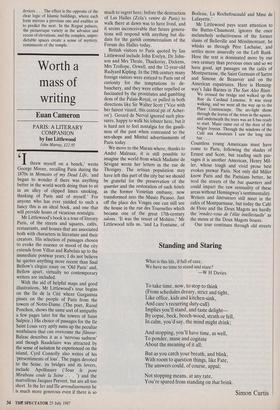Palaces that resist interpretation
Andrew Robinson
THE RAJPUT PALACES: THE DEVELOPMENT OF AN ARCHITECTURAL STYLE 1450-1750 by G. H. R. Tillotson Yale, DO Visitors to India, as well as Indians themselves, are usually utterly captivated by the Rajput fortress-palaces of modern Rajasthan, once Rajputana of martial fame, and western Madhya Pradesh, south of Delhi. The most famous are those at Jodhpur, Jaiselmer, Udaipur, Jaipur, Chi- tor and Gwalior. Dr Tillotson, who has expanded a doctoral dissertation into an absorbing and magnificent study (some poor black-and-white reproductions not- withstanding), was once himself an awe- struck tourist, frustrated by the - lack of available information.
The early architectural historian Fergu- son, though susceptible to the palaces, gave them no more than a cursory nod in his monumental study of India of 1876, and subsequent scholars have tended to follow his lead. The palaces are, inconveniently, secular Hindu architecture produced in a period which British historians and, until
recently, most Indian historians, had re- served for the Muslims, and for the Moghuls in particular. They were therefore mainly regarded as offshoots of Moghul architecture. The fact that there is no extant secular Hindu architecture predat- ing the palaces, despite the existence of masses of temples, helped to confirm the rightness of this view.
It is, however, wrong, as Tillotson ably shows. The oldest surviving Rajput palace, at Chitor, dates from 1433-68, much of the citadel of Gwalior from 1454-1518. Babur, the first Moghul, did not invade India until 1525; and Humayun's tomb, the first major Moghul building, dates from 1564-72, the Taj Mahal from 1632-48. Moghul building was in fact influenced by Rajput traditions, and of course vice versa, but the two inspirations remained separate, even if the craftsmen involved were often the same.
The inner apartments of the palace at Jodhpur (here illustrated), built about 1640, bear many of the typical features of the Rajput style and the Hindu impulse to adorn: cusped arches, falls or pierced marble screens, and the bangaldar eaves (originating from Bengal) That overhang the windows like roosting birds of prey. Such delicate arches are the delight of Moghul architecture too, as in the Fort at Agra, but they are first found much earlier, on Hindu sacred buildings, then in Rajput architecture, and only finally in Moghul buildings, where they were perfected and eventually ruined by over-use.
The mysterious charm of the best Rajput buildings lies in the complexity and ambi- guity of their planning and spatial arrange- ment, which Tillotson nicely analyses as their 'elusion', deliberately eschewing the over-worked 'elusiveness'.
It is no mere eastern exoticism; it is a refusal to be easily read, achieved by calculated
Jodhpur Fort Palace: east range of the old Zenana Chowk
devices . . . The effect is the opposite of the clear logic of Islamic buildings, where each form mirrors a previous one and enables us to predict the next. In the Rajput palaces, the picturesque variety in the advance and recess of elevations, and the complex, unpre- dictable spaces create a sense of mystery, reminiscent of the temple.



















































 Previous page
Previous page